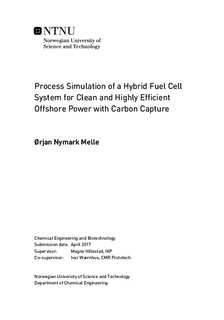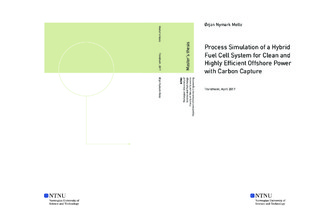| dc.description.abstract | Today, offshore power is mainly produced onsite by gas turbines and the process is responsible for the majority of the CO2-emissions from the Norwegian offshore industry. To reduce CO2-emissions offshore, electrification of the Norwegian continental shelf by long power cables from renewable onshore power production has been on the political agenda since the mid nineties, however, due to cost, only a few facilities are currently supplied by onshore power. By replacing the gas turbines with a highly effective hybrid fuel cell system, CMR Prototech has suggested an alternative solution that combined with carbon capture and storage may potentially produce clean and highly efficient offshore power (CHEOP).
To replace today's offshore gas turbines, a topside concept capable of delivering 32 MW of electrical power is required. In that context, CMR Prototech has developed a proposed P&ID of a scaled-down CHEOP process that delivers 3.2 MW of electrical power at an electrical efficiency of 60% without carbon capture.
In this work, a flow-sheet model of CMR Prototech's suggested CHEOP process with carbon capture was simulated in Aspen HYSYS to investigate its potential to produce clean and highly efficient power offshore. However, to be able to implement the proposed process in HYSYS, the membrane reactor of the CHEOP process was replaced by an already existing process route for syngas production and hydrogen separation as there is no specific unit operations that models the behaviour of membrane reactors in Aspen HYSYS, and to model one is outside the scope of this thesis.
Hence, based on the nominal operating conditions of CMR Prototech's proposed CHEOP process and a literature review of hydrogen production technologies, an equilibrium-based flow-sheet model of the CHEOP process with carbon capture was developed in Aspen HYSYS to investigate its potential performance in this work. Furthermore, a sensitivity analysis and a heat integration were also performed to study how the process behave and its potential for further improvements.
The simulation results show that at nominal operating conditions, the process has a net electrical power output of 2.89 MW and an electrical plant efficiency of 56.4%, which is excellent considered that the carbon capture process is included. Furthermore, approximately 400 kW of high quality excess heat from the oxyfuel-combustor are available for utilization in the reformer that will increase the hydrogen production and thus also the electrical power output and efficiency of the process if utilized. However, even though the additional heat is utilized, the SOFC is responsible for approximately 40% of the electrical power generation of the process. In CMR Prototech's proposed process the SOFC is only responsible for approximately 22% of the total power generation. This means that due to the energy demand of the reformer, a quite big SOFC will be needed in the more conventional process simulated in this work. This may become a problem with regards to size and weight on offshore facilities. | |

